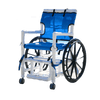Debunking Common Misconceptions About Wheelchairs

For millions of people worldwide, wheelchairs are essential tools that provide mobility, independence, and access to daily life. However, misconceptions about wheelchairs and their users can lead to stigma, misunderstandings, and unnecessary limitations. These myths not only affect the perception of wheelchair users but also influence how society addresses accessibility and inclusivity. In this article, we’ll address some of the most common misconceptions about wheelchairs to promote a more informed understanding of mobility, independence, and adaptability.
1. Misconception: All Wheelchair Users Are Completely Immobile
One of the most pervasive myths is that anyone using a wheelchair is completely unable to walk. In reality, many wheelchair users can stand, take a few steps, or walk short distances. However, they may rely on a wheelchair for longer distances or to conserve energy due to conditions like multiple sclerosis, arthritis, or chronic fatigue syndrome, which can make walking painful or exhausting. Wheelchairs serve as vital tools to help users maintain their daily activities and reduce physical strain rather than indicating complete immobility.
Supporting Fact: A CDC study found that over 13% of wheelchair users can walk short distances but use wheelchairs to prevent pain, fatigue, and further health complications (CDC, 2021). This highlights that wheelchair use can often be about managing energy and ensuring safety rather than a complete inability to walk.
2. Misconception: Wheelchairs Limit Independence
Another common misconception is that using a wheelchair restricts independence, creating dependency on others. However, for many individuals, a wheelchair represents the opposite—enhancing autonomy and freedom by allowing them to move without constant assistance. Whether manual or powered, wheelchairs enable users to navigate their surroundings with ease, increasing their access to work, social events, and daily errands.
Supporting Fact: Today’s modern wheelchairs offer advanced features, such as customizable seating, adjustable controls, and easy-to-navigate power systems, allowing users to adapt their mobility aids to their specific needs. This customization can support more active, independent lifestyles (American Academy of Physical Medicine and Rehabilitation, 2021).
3. Misconception: All Wheelchairs Are the Same
Not all wheelchairs are created equal, and there is a vast variety designed to meet diverse needs. Wheelchairs range from manual to power-operated, as well as specialized types like sports wheelchairs, pediatric wheelchairs, and bariatric models. The type of wheelchair someone chooses depends on their physical condition, lifestyle, and long-term mobility goals. For example, active individuals might prefer a lightweight sports wheelchair, while those requiring greater support might opt for a power chair with advanced seating systems.
Supporting Fact: The World Health Organization (WHO) emphasizes that selecting the right wheelchair is essential for the user’s health and mobility, as a poorly fitted chair can lead to physical complications and limited movement. Proper assessment and customization are critical to ensuring comfort and functionality (WHO, 2021).
4. Misconception: Wheelchairs Are Only for the Elderly
While it’s true that many older adults benefit from wheelchairs, people of all ages, including children and young adults, may need mobility aids due to various conditions, injuries, or disabilities. The misconception that wheelchairs are only for seniors can be limiting, as it overlooks the needs of younger individuals who rely on them for daily activities, education, or work.
Supporting Fact: According to the American Journal of Physical Medicine & Rehabilitation, approximately 1.7 million Americans under the age of 65 use wheelchairs or other mobility aids due to disability or injury. This statistic highlights the diverse population that depends on wheelchairs for independence (American Journal of Physical Medicine & Rehabilitation, 2021).
5. Misconception: Using a Wheelchair Means Giving Up on Physical Activity
A common misconception is that wheelchair use equates to a sedentary lifestyle, but many wheelchair users lead active and even athletic lives. Adaptive sports, such as wheelchair basketball, tennis, and racing, have grown in popularity, allowing wheelchair users to engage in physical fitness, compete, and pursue active hobbies. Advances in sports wheelchairs have made it possible for individuals to participate in various sports, maintain fitness, and even compete at national and international levels.
Supporting Fact: Organizations like the National Wheelchair Basketball Association and the Adaptive Sports USA promote physical activity and athletic opportunities for wheelchair users. Adaptive sports programs demonstrate that wheelchairs are not barriers to fitness but can be tools that support an active, healthy lifestyle (National Wheelchair Basketball Association, 2021).
6. Misconception: Wheelchairs Are Uncomfortable and Unattractive
Some people assume that wheelchairs are uncomfortable or bulky, but modern designs have come a long way in terms of aesthetics and comfort. Today’s wheelchairs are more customizable than ever, with ergonomic seats, lumbar support, lightweight frames, and even stylish designs that cater to the user’s preferences. Custom wheelchairs offer a blend of comfort, functionality, and style, empowering users to express themselves through their mobility aids.
Supporting Fact: Manufacturers now provide a range of options in materials, colors, and styles, allowing wheelchair users to personalize their equipment. Comfort features like contoured seats and shock-absorbing wheels have become common in many models, helping to enhance users’ experiences and satisfaction with their chairs.
Conclusion
Misconceptions about wheelchair use can contribute to stigma, misunderstandings, and unnecessary limitations on wheelchair users’ lives. By addressing these myths and promoting a realistic understanding, we can foster a more inclusive society where mobility aids are seen as empowering tools rather than symbols of limitation. Wheelchairs offer freedom, mobility, and a pathway to active living, regardless of age or ability level.
If you or someone you know is considering using a wheelchair, consult healthcare professionals or mobility specialists to explore options that fit individual needs, lifestyle, and mobility goals. With the right information and support, wheelchairs can transform lives and open up a world of possibilities.
- Dansons Medical Support


 Lifts
Lifts
 Patient Lifts
Patient Lifts
 Stand Assists
Stand Assists
 Standing Aids
Standing Aids
 Slings
Slings
 Parts & Accessories
Parts & Accessories
 Wheelchairs
Wheelchairs
 Ergonomic
Ergonomic
 Portable
Portable
 Reclining
Reclining
 Standing
Standing
 Sporting
Sporting
 Bariatric
Bariatric
 Ramps
Ramps
 Modular
Modular
 Portable
Portable
 Parts & Accessories
Parts & Accessories
 Walking Aids
Walking Aids
 Rollator Walkers
Rollator Walkers
 Canes
Canes
 Crutches
Crutches
 Parts & Accessories
Parts & Accessories
 Scooters
Scooters
 4-Wheel
4-Wheel
 Folding
Folding
 Parts & Accessories
Parts & Accessories
 Nursing
Nursing
 Pregnancy Comfort
Pregnancy Comfort
 Self-Care
Self-Care
 Pump Parts
Pump Parts
 Exercise Equipment
Exercise Equipment
 Treadmills
Treadmills
 Walking Pads
Walking Pads
 Rowing Machines
Rowing Machines
 Strength & Conditioning
Strength & Conditioning
 Massage Chairs
Massage Chairs
 Saunas
Saunas
 Hot & Cold Tubs
Hot & Cold Tubs
 Stethoscopes
Stethoscopes
 Surgical Instruments
Surgical Instruments
 Forceps
Forceps
 Scalpels
Scalpels
 IV Poles
IV Poles
 Oxygen
Oxygen
 Beds
Beds
 Electric Beds
Electric Beds
 Standing Beds
Standing Beds
 Mattresses
Mattresses
 Bed Accessories
Bed Accessories
 Bed Parts
Bed Parts
 Chairs
Chairs
 Medical Recliners
Medical Recliners
 Phlebotomy Chairs
Phlebotomy Chairs
 Stools & Task Chairs
Stools & Task Chairs
 Parts & Accessories
Parts & Accessories
 Tables
Tables
 Overbed Tables
Overbed Tables
 Medical Tables
Medical Tables
 Recovery Couches
Recovery Couches
 Cabinets
Cabinets
 Pool
Pool
 Pool Lifts
Pool Lifts
 Pool Fitness & Therapy
Pool Fitness & Therapy
 Pool Access Chairs
Pool Access Chairs
 Slings
Slings
 Parts & Accessories
Parts & Accessories
 Bath
Bath
 Toileting Aids
Toileting Aids
 Bath Lifts
Bath Lifts
 Shower Seats
Shower Seats
 Parts & Accessories
Parts & Accessories
 Portable Shower
Portable Shower
 Dansons Products
Dansons Products
 Transfer Aids
Transfer Aids
 Cushions
Cushions
 eBooks
eBooks
 Helpful Articles
Helpful Articles
 Reviews
Reviews
 Contact Us
Contact Us
 Create Account
Create Account
 Request a Quote
Request a Quote

Comments 0